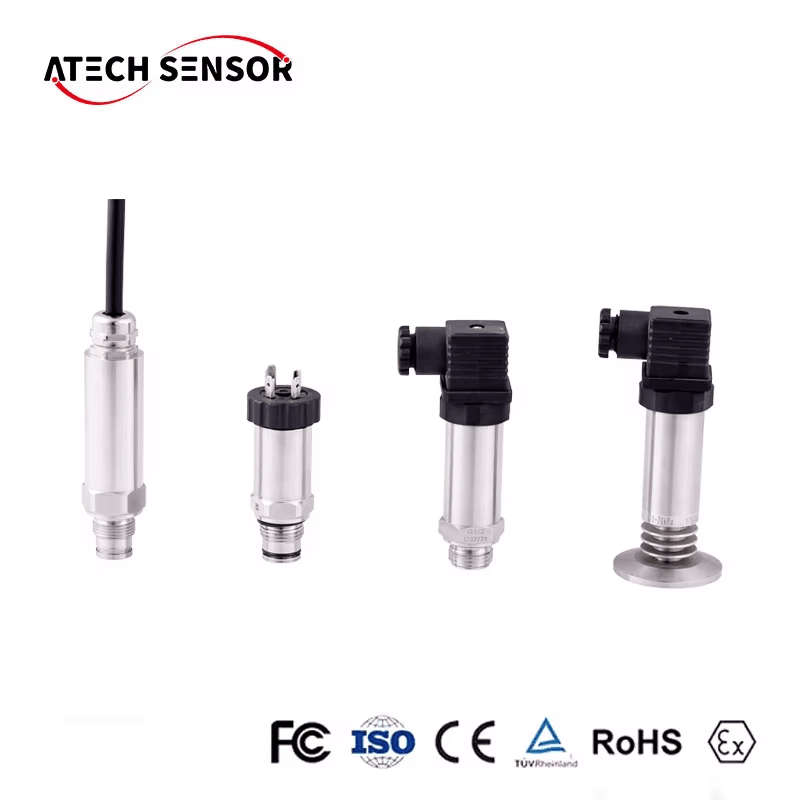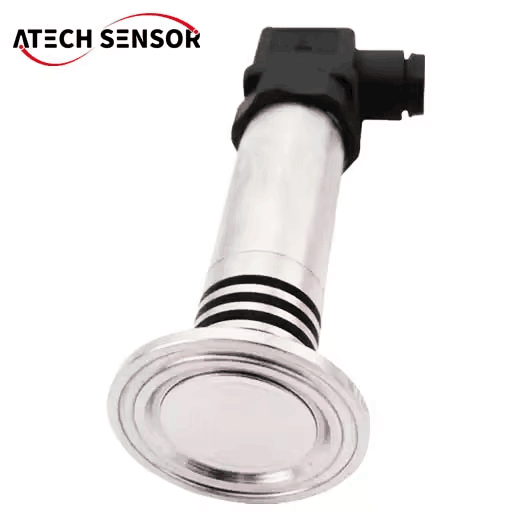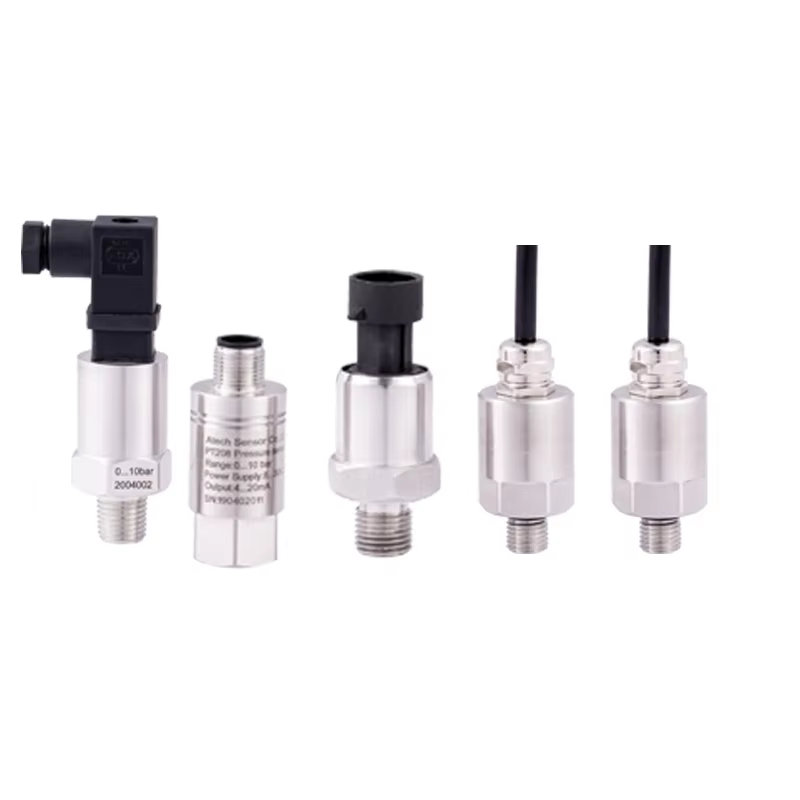Pressure transmitter is a kind of pressure will be converted into pneumatic signal or electric signal for control and remote transmission equipment.
It can convert the physical pressure parameters of gas, liquid, etc. sensed by the sensor of the pressure measuring element into standardized electrical signals (e.g., 4-20mADC, etc.) to be supplied to secondary instruments such as indicator alarms, recorders, regulators, and so on, for measurement, indication, and process adjustment.

Basic Introduction
Pressure transmitter is one of the most commonly used sensors in industrial practice, which is widely used in a variety of industrial self-control environment, involving water conservancy and hydropower, railroad and transportation, intelligent buildings, production automation, aerospace, military, petrochemical, oil wells, electric power, ships, machine tools, pipelines and many other industries.
There are two major types of pressure transmitters: electric and pneumatic.The unified output signal of electric type is DC signal such as 0-10mA, 4-20mA or 1-5V.The unified output signal of pneumatic type is gas pressure from 20 to 100 Pa.
Pressure transmitter according to different conversion principles can be divided into force (torque) balance, capacitive, inductive, strain and frequency type, etc., the following briefly introduces the principle, structure, use, maintenance and calibration of several pressure (differential pressure) transmitter knowledge.
The main role of the pressure transmitter to the pressure signal to the electronic equipment, and then in the computer to display the pressure of its principle is roughly: the water pressure of this pressure mechanics signal into a current (4-20mA) such electronic signals pressure and voltage or current size into a linear relationship, generally proportional to the relationship.Therefore, the transmitter output voltage or current increases with the increase in pressure thus deriving a pressure and voltage or current of the relationship between the pressure transmitter of the measured medium of the two pressures into the high and low pressure chamber, the low pressure chamber pressure using atmospheric pressure or vacuum, the role of the δ element (i.e., the sensitive element) on both sides of the isolation diaphragm, through the isolation sheet and the element within the filler fluid is transmitted to the measurement of the diaphragm on both sides.
The pressure transmitter is a capacitor consisting of a measuring diaphragm and an electrode on each side of the insulating piece.When the two sides of the pressure is not consistent, resulting in the measurement of diaphragm displacement, the displacement and pressure difference is proportional to the two sides of the capacitance is not equal, through the oscillation and demodulation link.

Working Principle
The electrical component of the pressure transmitter that feels the pressure is generally a resistance strain gauge, which is a sensitive device that converts the pressure on the measured part into an electrical signal.Resistive strain gauges are most commonly used as metal resistive strain gauges and semiconductor strain gauges.There are two kinds of metal resistance strain gauges, namely, filament strain gauges and metal foil strain gauges.Usually, the strain gauges are tightly bonded to the mechanical strain generating substrate through special adhesives. When the substrate is subjected to stress changes, the resistance strain gauges will also deform together, so that the resistance value of the strain gauges will be changed, which will make the voltage applied on the resistor change.
Main performance
1. The use of a wide range of measured media, can measure oil, water and 316 stainless steel and 304 stainless steel compatible with the paste, with a certain degree of corrosion resistance;
2. high accuracy, high stability, the use of imported original sensors, good linearity, high temperature stability;
3. small size, light weight, installation, commissioning, easy to use;
4. stainless steel, fully enclosed shell, waterproof;
5. pressure sensors directly sensed by the measured levelPressure, not affected by the medium blistering, deposition.

Key Benefits
1、Pressure transmitter with reliable operation, stable performance and other characteristics; 2、Dedicated V / I integrated circuits, fewer peripheral devices, high reliability, maintenance is simple, easy, small size, light weight, installation and commissioning is extremely convenient;
3、Aluminum alloy die-casting shell, three-terminal isolation, electrostatic spraying of the protective layer, sturdy and durable;
4、4-20mA DC two-wire signal transmission, anti-jamming ability, transmission distance;
5、LED, LCD, pointer three indicator head, on-site reading is very convenient;Can be used to measure viscous, crystalline and corrosive media;
6, high accuracy, high stability.In addition to the imported original sensor has been corrected with a laser, the entire machine in the use of temperature range of the comprehensive temperature drift, non-linearity of fine compensation.
Selection rules
1. According to the type of pressure to be measured The main types of pressure are gauge pressure, absolute pressure, differential pressure and so on.Gauge pressure refers to the atmosphere as a reference, less than or greater than the atmospheric pressure; absolute pressure refers to the absolute pressure zero as a reference, higher than the absolute pressure; differential pressure is the difference between the two pressures.
2. According to the measured pressure range In general, according to the actual measurement of pressure for the measurement range of 80% selection.To consider the maximum pressure of the system.In general, the pressure transmitter pressure range maximum should be 1.5 times the maximum system pressure value.Some water pressure and process controls have pressure spikes or continuous pulses.These spikes can be up to 5 or even 10 times the "maximum" pressure and can cause damage to the transmitter.Continuous high-pressure pulses, approaching or exceeding the transmitter's maximum pressure rating, can shorten the useful life of the transmitter.However, increasing the transmitter pressure rating sacrifices the resolution of the transmitter.Buffers can be used in the system to attenuate spikes, which can reduce the response of the sensor.Pressure transmitters are generally designed to withstand maximum pressure for 200 million cycles without degradation of performance.In the selection of transmitters can be found in the system performance and transmitter life between a compromise solution.
3. According to the measured medium According to the different measurement media can be divided into dry gas, gas and liquid, strong corrosive liquids, viscous liquids, high-temperature gases and liquids, etc., according to the correct selection of different media is conducive to prolonging the service life of the transmitter.
4. According to the maximum overload of the system The maximum overload of the system should be less than the overload protection limit of the transmitter, otherwise it will affect the service life of the transmitter or even damage the transmitter.Usually the safe overload pressure of the pressure transmitter for the full range of 2 times.
5. According to the required accuracy level The measurement error of the transmitter is divided according to the accuracy level, and different accuracy levels correspond to different basic error limits (expressed as a percentage of full scale output).In practice, according to the measurement error control requirements and in line with the principle of using the economy of choice.
6. According to the system operating temperature range Measuring medium temperature should be within the operating temperature range of the transmitter, such as over-temperature use, will produce a large measurement error and affect the service life of the transmitter; in the production process of the pressure transmitter, will be measured and compensated for the effects of temperature to ensure that its temperature-induced measurement error is within the range of the accuracy level requirements.In the higher temperature occasions, you can consider choosing high temperature type pressure transmitter or take the installation of condensate tubes, radiators and other auxiliary cooling measures.
7. According to the measurement medium and contact material compatibility In some measurement occasions, the measurement medium is corrosive, then you need to choose the measurement medium compatible with the material or a special process to ensure that the transmitter is not damaged.
8. According to the form of pressure interface Usually threaded connection (M20 × 1.5) for the standard form of interface.
9. According to the power supply and output signal Usually the pressure transmitter DC power supply, to provide a variety of output signals to choose from, including 4 ~ 20mA, DC;, 0 ~ 5V, DC, 1 ~ 5V, DC, 0 ~ 10mA, DC, etc., there can be a 232 or 485 digital output.
10. According to the site working environment and other
Whether there is vibration and electromagnetic interference, etc., should be provided when selecting the relevant information in order to take corresponding treatment.When selecting the type, other such as electrical connections can also be considered on a case-by-case basis.

Installation Instructions
In the installation and use of pressure transmitters should be read in detail before the product samples and instructions for use, the installation of the pressure interface can not be leaked, to ensure that the range and wiring is correct.Pressure sensor and transmitter shell generally need to be grounded, signal cable shall not be mixed with power cable laying, sensors and transmitters should be avoided around the strong electromagnetic interference.
Instructions for use
Daily maintenance
1, check the size of the mounting hole: if the size of the mounting hole is not appropriate, the sensor in the installation process, the threaded part of the sensor will be easily subjected to wear and tear.This will not only affect the sealing performance of the device, but also so that the pressure sensor can not give full play to its role, and may even produce safety hazards.Only the appropriate mounting holes to avoid thread wear (thread industry standard 1/2-20 UNF 2B), you can usually use the mounting hole gauge to detect the mounting holes to make appropriate adjustments.
2, keep the mounting holes clean: keep the mounting holes clean and prevent the melt from clogging to ensure the normal operation of the equipment is very important.Before the extruder is cleaned, all pressure sensors should be removed from the barrel to avoid damage.During the removal of the transducers, melt may flow into the mounting holes and harden, and if this residual melt is not removed, the top of the transducer may be damaged when it is reinstalled.The cleaning kit removes this melt residue.However, repeating the cleaning process may deepen the damage to the sensor caused by the mounting holes.If this happens, measures should be taken to elevate the sensor in the mounting hole.
3, choose the right location: when the pressure sensor is installed too close to the upstream of the production line, the unmelted material may wear the top of the sensor; if the sensor is installed in too far back position, between the sensor and the screw stroke may produce a stagnant zone of molten material, where the melt may produce degradation, the pressure signal may be transmitted distortion; if the sensor is too far back into the barrel, the screw may touch the top of the sensor during rotation and cause damage to it.If the sensor is too deep into the barrel, the screw may touch the top of the sensor during rotation and damage it.Generally, sensors can be located on the barrel in front of the screen, in front of or behind the melt pump, or in the mold.
4, careful cleaning; before using wire brushes or special compounds to clean the extruder barrel, all sensors should be disassembled.Both of these cleaning methods may cause damage to the vibration membrane of the sensors.When the barrel is heated, the transducer should also be removed and the top wiped with a soft, non-abrasive cloth, while the transducer holes need to be cleaned out with a clean drill and guide.
Correct use of pressure sensors should pay attention to the use of the process to consider the following:
1, to prevent the transmitter and corrosive or overheated media contact;
2, to prevent the deposition of dross in the conduit;
3, the measurement of liquid pressure, the take-off port should be opened on the side of the process piping, in order to avoid the precipitation of slag accumulation;
4, the measurement of gas pressure, the take-off port should be opened at the top of the process piping, and the transmitter should be mounted in the process piping on the upper part of the process piping in order toAccumulated liquid can be easily injected into the process piping;
5, the pressure guide tube should be installed in the temperature fluctuations of small places; 6, the measurement of steam or other high-temperature media, need to be connected to the addition of buffer tubes (coils) and other condensers, should not be more than the limit of the transmitter's operating temperature;
7, when freezing occurs in the winter, the transmitter must be installed in the outdoors to take anti-freezing measures, to avoid freezing of the liquid in the pilot port due to volume expansion, resulting in sensor
8, when measuring liquid pressure, the transmitter should be installed to avoid the impact of liquid (water hammer), so as to avoid overpressure damage to the sensor;
9, wiring, the cable through the waterproof connector (accessory) or winding tube and tighten the sealing nut to prevent rainwater leakage through the cable into the transmitter shell.

